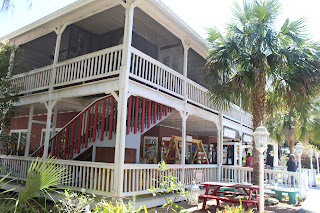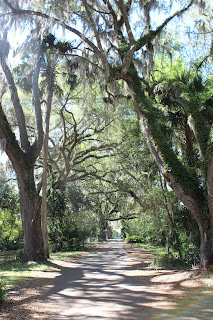Monday, March 17th I drove to the smallest inland town in Florida: Micanopy. First stop was at Barr Hammock Preserve. It's swampy on either side but has a wide path, perfect for walking or biking. There were only a couple people in this preserve so it was very peaceful and quiet. A guy showed me pictures of an alligator that had been sunning on the path, and he had gone right up to it and taken photos, so I walked on the path for a while but never saw it.
The historic town is only one square mile, and a short drive from the preserve. There's plenty of space to park and walk around. I went during the week so it wasn't too crowded. Only 600 something people live in this town. Here's a little more info:
Founded after Spain relinquished Florida to the United Sates in 1821, Micanopy became the first distinct American town founded in the new US territory. Originally an Indian trading post, Micanopy was built under the auspices of the Fl. Association of New York. A leading member of this company, Moses Levy, along with Edward Wanton, a former Anglo-Spanish Indian trader, played important roles here. In 1822, a select group of settlers and skilled craftsmen departed New York harbor and set sail for Fl. After disembarking on the banks of the St. Johns River, (at present day Palatka) and with the added labor of 15 slaves, these men forged a 45-mile road with 8 bridges to Micanopy - a vital new pathway into the interior. These first settlers arrived on Feb. 12, 1823, and were in close contact with both Seminole and Miccosukee Indians, as well as the black descendants of runaway slaves who resided among them. Micanopy means "head chief," a title awarded to the leader of the Alachua Seminoles.
The onset of the second Seminole War in Dec. 1835 caused great devastation. Nearby sugar plantations and homesteads were burned and entire families sought the safety of Micanopy, which had been barricaded with log pickets and renamed Fort Defiance by the military. During the summer of 1836, the Battle of Micanopy and the Battle of Welika Pond took place here. On August 24, with most soldiers sick or wounded, the US Army evacuated the fort and town and all buildings were intentionally burned. Afterward, Fort Micanopy was erected in 1837. The town was rebuilt after the Seminole War, with few of the original inhabitants returning. Cotton replaced sugar cane as a staple crop and cattle production assumed new importance. Following the Civil War and with the advent of the railroad, the Micanopy area became known as the "leading orange and vegetable growing section of Fl." After a freeze in 1894-95, orange cultivation was curtailed, but farmers continued to flourish by growing winter vegetables for northern markets. By the 1920s, truck farming was largely displaced by the lumber and turpentine industries. Many of the town's larger surviving homes reflect the previous area of agricultural prosperity.
Coffee & Cream Cafe was 1 of 2 restaurants that were open (because of St. Patrick's Day), and it was quite busy.
It offers indoor and outdoor seating. That day there were 2 people providing live music on the porch.
They sell walking sticks inside with these carved animals on the top.
Old Florida Cafe was closed but I talked to the owner for a while. She bought it from the original owner, who's in his 90s now, and she makes all the food for it.
Gorgeous flowers are everywhere! These purple ones smell amazing. If you know the name of these please comment!
Mosswood Farm Store sells coffee, tea, baked goods, preserves, and more.
Here's the library... and below is a baptist church.
There's a handful of stores to browse through, with many antique shops, so if that's your shopping jam, you'd love this. :)
The Sherouse Garage stood at the curve of what used to be the main highway south. It previously housed the Micanopy Historical Society Museum and Library and the ice cream parlor.
Small oranges
As you're walking on the sidewalk, if you're not paying attention, you might miss this rock. It was built in 1853 by Dr. James A. Cooper as first an apothecary shop, then later became the stagecoach stop, then the first post office. The old stage route entered Micanopy from west on present Seminary St. The first telephone office was also here.
Click on this photo to read more about Moses Levy.
I walked to the cemetery, which was a couple blocks away. Here are some sights along the way.
This Montgomery wall was built around 1895 to define the boundary of the estate and 3 homes. The homes were destroyed in a fire and only the wall was left standing. It was damaged in 2015 by an oak branch during a storm, but has since been restored.
So many beautiful moss-draped live oaks around.
One of my favorite activities is visiting old cemeteries and reading tombstones. This one was probably the most beautiful one I've walked through, with tons of oak trees and blooming flowers. 

If you drive there's a large space for parking.
That concludes this day in Micanopy, Fl. If passing by, I recommend stopping and walking around. It's only 10 minutes off I-75 and 12 miles from Gainesville. These small towns of Fl. are little gems. Keep following along for more explorations!


































































































No comments:
Post a Comment
Hello there!
I'd love it if you left me a comment...they totally make my day!